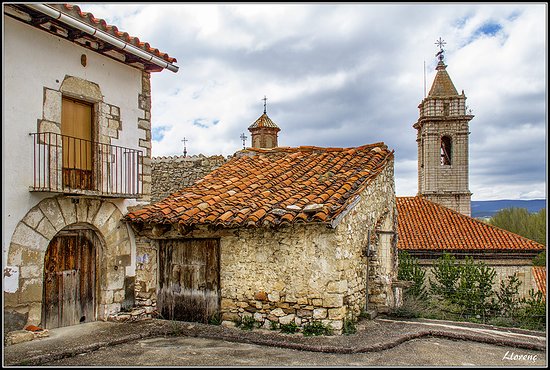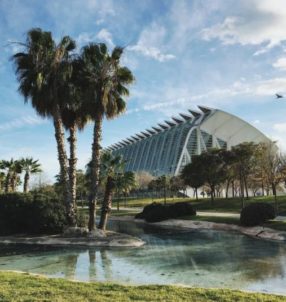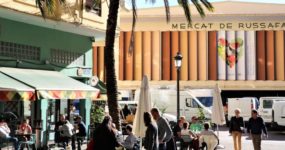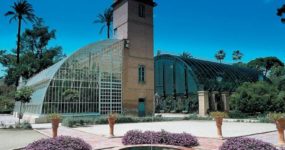##On July 11 (2021), the Cultural Association ‘The Way of the Holy Grail’ held an information day on Sunday morning in Fortanete.
The event consisted of a conference on the Holy Grail by Dr. Ana Mafé García, president of the Cultural Association The Way of the Holy Grail and an exhibition on ‘The Way of the Holy Grail’ and its impact on the territory, by Mr. Paco Miguel Gómez, a local resident and member of the Association.
The table of speakers included the participation of Mr. Luis Gil, Mayor of the City Council of Fortanete, who presented to all attendees the importance of being present in the story of this wonderful historical, cultural and legendary journey.
Fortanete is a privileged enclave. At more than 1,300 metres above sea level and its streets breathe history.
In 1169 Alfonso II of Aragon incorporated these lands to his kingdom as regards the Almohad kingdom of Valencia, in which there are two castles, Fortaner and the so-called Castillo del Cid, 6 km north of Fortanete, from the Muslim period and known for the raids of ‘El Cid’ already in the eleventh century.
Pedro II, King of Aragon and Count of Barcelona, gave the castle of Fortaner in 1202 to the Order of the Hospital of St. John of Jerusalem, belonging to the Encomienda de Aliaga.
During the sixteenth and seventeenth centuries there was great economic prosperity, which was reflected in the architecture of the town. From this period comes the Town Hall (XVI century) and the Parish Church (late XVII century), as well as several ancestral homes. Its livestock wealth, of which its sheep herd was outstanding, allowing the development of the textile manufacture of wool, which was exported to the regions of Levante and Catalonia.
From the middle of the XVIII century there was a strong increase in the population, increasing the farmland and the number of farmhouses, which affected the livestock.
The 19th century was a period of political and social upheaval, with the Carlist Wars… where, after several skirmishes, the Carlists abandoned the village. Marqués de Amarilla established in Fortanete the necessary stores for the Siege of Cantavieja.
Between the 1950s and 1980s there was a strong emigration, until its population was reduced to two hundred citizens…having had a population of 1,800 citizens at the turn of the 20th century.
The road as it passes through Fortanete…
You cannot miss a visit to these buildings:
– Town Hall, Renaissance-style building, built in the sixteenth century, with masonry and ashlar stone. Its construction began in 1520. On the first floor there is a market, with three semi-circular arches, and the jail and dungeons, which are accessed through a semi-circular arched door. On the main floor are the municipal offices, archive room and meeting room.
– Parish Church, from the XVII century.
– House of the Dukes of Medinaceli, noble palace of the XVI century, on three levels built with masonry and ashlar masonry, and topped with wooden eaves of great flight. The palace has a splendid Renaissance style balcony.
– House of the Marquis of Villasegura, former barracks (16th-17th century), the House of the Dukes (16th century).
– House of Escorihuela (XVII century), and other buildings of interest.
– Hermitage of Nuestra Señora de Loreto (XVII century).
– Bridge over the Pitraque River, with a single span and a lowered arch, with the usual inclination of the deck of medieval bridges.
Fortanete, after the reconquest and due to its geographic situation, became a centre of operations for the passage of livestock and people, today this geographic situation is still used to travel from Fortanete to three Aragonese regions and the neighbouring region of Castellón de Els Ports, being an ideal place to spend the night when snow activities are performed, (it is the closest town to the ski slopes of Valdelinares on the north side) reducing the time of access to the slopes and avoiding traffic jams.
It is also part of the Pitarque Loop, which is formed by the villages of Fortanete, Villarroya de los Pinares, Miravete de la Sierra, Pitraque, Montoro de Mezquita, Villarluengo and La Cañada de Benatanduz, this particular route is the most unknown, endearing and deepest of the Maestrazgo Turolense.
The Territory around the Pitraque River made its entry into history thanks to the Reconquest, since the Order of the Hospital of St. John of Jerusalem and the Order of the Temple placed it as the most important place in its surroundings, occupying the lands of two Bailiwicks.
Enhancing the value of the Grail Territory
The Cultural Association The Way of the Holy Grail, on the occasion of the second Jubilee Year of the Holy Chalice of the Cathedral of Valencia, is highlighting the significance, potential and future capacity that this concept represents in a total of nine municipalities of Teruel through the celebration of the 63rd anniversary of the passage of the Holy Chalice of the Cathedral of Valencia through the province of Teruel.
From July 2 to 14th, 2021 and from September 15 to November 5, 2021, this anniversary will be celebrated by making known all the benefits of the Way of the Holy Grail in the municipalities of Ejulve, Fortanete, Villarroya de los Pinares, Cerveruela, Las Cuevas de Cañart, San Agustín, Albentosa, Sarrión and La Puebla de Valverde. Municipalities that comprise the Maestrazgo Grail Territory and the Way of the Holy Grail in the province of Teruel.
Report by ‘24/7 Valencia’ team
Related Post
This site uses Akismet to reduce spam. Learn how your comment data is processed.

























Leave a comment